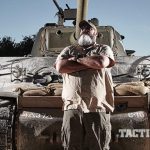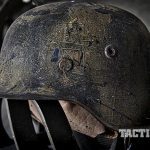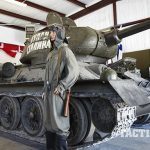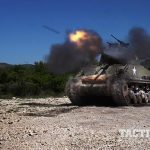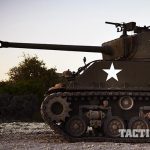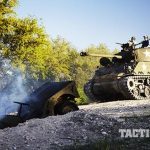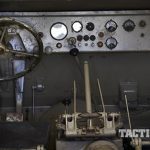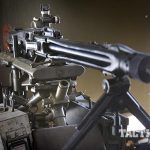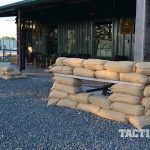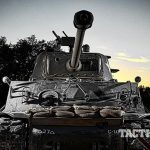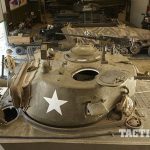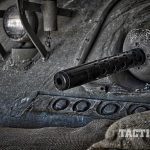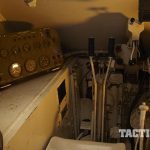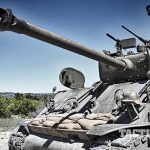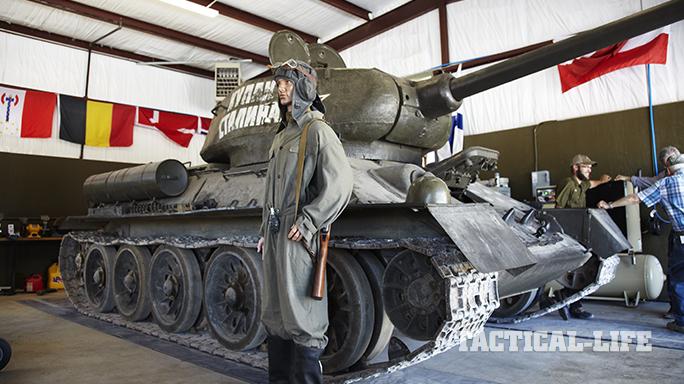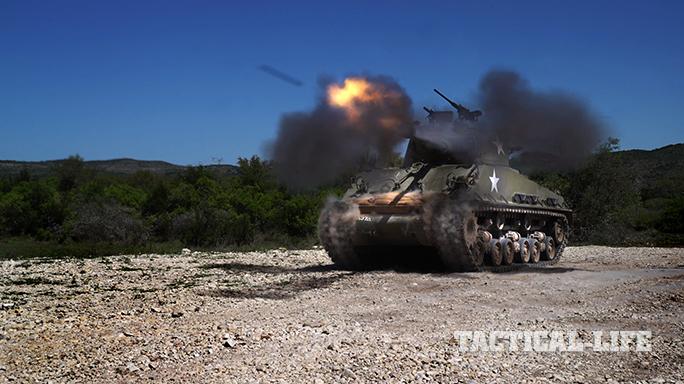
Category: This looks like a lot of fun to me!
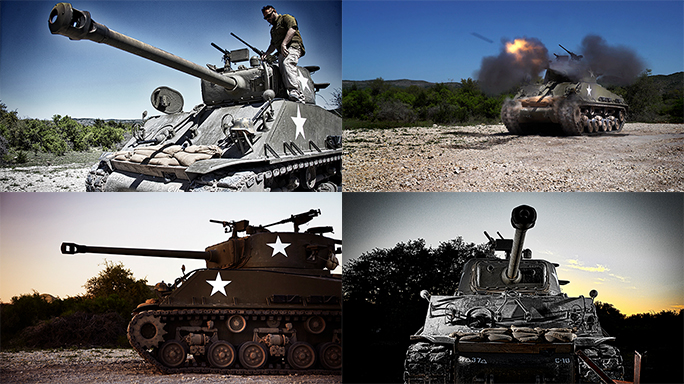
Jason and I each sat alone in the bleachers during seventh-grade gym class, a pair of skinny, forlorn children new to the school and caught hopelessly within the pitiless throes of puberty. We were the chemical formula for awkward. Of roughly the same size and build, we were frequently mistaken for brothers in subsequent years. A chance comment overheard that day sparked a conversation that orbited around Sherman tanks. For we were hopeless nerds who built plastic models and still played army when American society condoned such.
- RELATED VIDEO: Driving Tanks Is the Greatest Experience Ever
To turn a biblical metaphor, ours is a David and Jonathan friendship. We helped raise each other’s children and in the subsequent decades embarked on countless projects together, legal and otherwise. For example, our largest trebuchet sported a 12-foot throwing arm. It’s a miracle we survived.
When Jason’s dad grew grievously ill, we logged two days in the workshop building the great man’s casket. My friend stretched out on the floor of the shop so we could get the dimensions right. We laughed, cried and basked in the bonds of Christian brotherhood more deeply than might be imagined.
When I got an email inquiring whether I might be willing to trek to western Texas to drive and shoot a real Sherman tank, my next phone call was naturally to my best friend.
Texas Thunder

There’s actually a place in America where normal guys can drive and shoot real tanks. Naturally, it’s in Texas, oriented within the legendary Ox Ranch, about two hours west of San Antonio. Our first impressions of DriveTanks.com were thoroughly surreal.
We pulled off the rural county road expecting armored vehicles and gunnery ranges only to be greeted by a meandering herd of giraffes. Delving deeper into the bowels of the place, we passed buffalo, wildebeests, zebras, ostriches, kangaroos and some prehistoric-looking bovines called watusi. These simply gigantic pseudo-cows sport horns the size of a Winnebago.
The Ox Ranch is 18,000 acres of pure, unfiltered paradise. A working game preserve and exotic hunting facility, the Ox Ranch hosts well-heeled hunters from throughout the world. DriveTanks.com shares the space and partakes of the same superlative amenities. The food grows on the ranch. The ranch’s world-class cooking staff prepares the meals and everything sports the highest levels of refinement and creature comforts. Imagine the Ritz-Carlton displaced to the African savanna along with a sprinkling of vintage armored vehicles. Now you have a decent mental image of the place.
After checking in at the palatial hunting lodge and signing the obligatory legal paperwork, we reported to the nearby tank barn. Screw Disneyworld, brothers. DriveTanks.com is where dreams really come true.
A Living Museum
The tanks are massive, imposing beasts crammed side by side into several contiguous maintenance buildings, but an M4A2E8 Sherman tank identical to the one used in the Brad Pitt movie “Fury” greets you upon arrival. Unlike Pitt’s tank, this one has fully functional weapons. In fact, all of the guns large and small are live.
A vintage camouflaged Waffen SS Sd.Kfz. 251 armored halftrack sits alongside the Sherman. Beyond the tracked Kettenkrad, the 25mm Pateau cannon and the only operational German Pak 40 75mm anti-tank gun in the country is the World War II-veteran Russian T34. The actual uniform and equipment worn by the Gordo character in Fury adorn a mannequin in the corner, and a uniformed reproduction of German Tiger ace Michael Wittmann keeps an eye on things.
An impressive array of belt-fed machine guns splays out in a semicircle from one wall, and an extensive collection of vintage and modern long guns and submachine guns is stacked along another. The rest of the walls are festooned with military artifacts recovered from battlefields across the globe. A fully stocked bar liberally decorated with period military ordnance and memorabilia overlooks the place.
The facility could pass for a well-equipped military museum. There is one notable exception: There are no ropes keeping you off of the stuff. Like sugar- fueled toddlers, Jason and I crawled up, around and through everything in the expansive collection, chattering feverishly with each new discovery. The unabridged English lexicon lacks the superlatives to adequately describe the awesomeness of this place.
The notion that percolates within the thinking man’s viscera when settling into these war machines, each the alpha predator of its respective age, is that this would be a simply horrible place to die. For all the machines’ power and ferocious, palpable capacity for chaos, the men locked within these 40-ton engines of combat were essentially entombed. In the hands of the greatest generation, this 1944-era Sherman. for example, wrested the world from the diabolical clutches of the Nazis with their formidable Panthers and Tigers.
Driving A Sherman
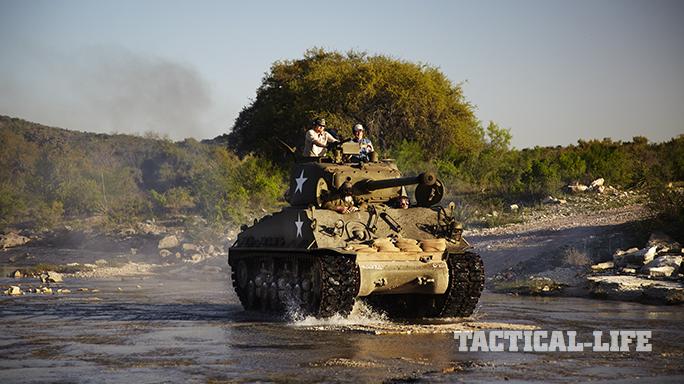
It falls to me to attempt—vainly, no doubt—to paint a word picture of what DriveTanks.com’s extensive facility was like. Hate me if you must, but I got paid to do this. Never let it be said that I’m unwilling to suffer for my art.
The experience was nothing like what I expected. Shermans weigh 80,000 pounds, so the immutable dicta of physics are most overtly at play behind the mass of these vintage machines. Even at 73 years old, the thing feels indestructible. The tank’s original twin Detroit diesels leap to life sequentially with the push of a button. I had to stand on the clutch to hold it in place, and the gearshift is floppy, like that of a 1930s-era roadster. Trading the clutch for gas is not unlike any manual transmission on a modern automobile, but the mass of the beast means you have to shift quickly lest the tank slow down unduly.
The Sherman steers via differential braking, so with the steering levers in the default position (fully forward), it goes where it is pointed. To turn, you torque back on the appropriate lever to slow the track on that side of the turn. Any serious maneuver requires both hands and some considerable effort, and the tank has a surprisingly wide turning radius.
The tank course would do Disney proud. You bypass a blown-out bridge before pitching into a steep riverbed and clanking up a shallow river. Simulated artillery fire spices up the ride. This particular course then takes you up a rise in the face of machine gun fire from a concrete pillbox before reaching the live-fire range.
The high-velocity 76mm gun throws a 14-pound steel projectile at about 2,500 feet per second. That’s like shooting a 98,000-grain bullet with the same velocity as an AK-47. You fire the gun via a lanyard from outside the turret so you can fully enjoy the downrange effects. The muzzle blast is adequate to clear your sinuses and, if care is not exercised, remove your glasses. Our shot destroyed an unfortunate Toyota before irrevocably burying itself within the ample backstop. Jason and I laughed until our faces hurt.
Making Memories At DriveTanks.com
You can glimpse the tools of war in many antiseptic museums. By contrast, a trip to DriveTanks.com puts you in the same seat doing the same things those awesome old guys did when they spanked the Nazis and subsequently saved the world. DriveTanks.com is the only place where you can drive vintage armored vehicles while also exercising their massive weapons systems. The sounds, vibrations and smells of these classic war machines inevitably strikes a visceral chord.
The experience isn’t cheap, but it’s an incredible value. You would spend more at an Orlando theme park and leave with half the memories. The day before we arrived, a 12-year-old child took the 84,000-pound Leopard around the course. Since the guns fire from fixed mounts, even children can run them safely. Imagine how that young man answered the question, “So what did you do over spring break, Timmy?”
I have traveled the world, parachuted out of airplanes in pitch darkness, flown combat helicopters, delivered 60 babies and saved more than a few lives. But I had never done anything like this. The experience at DriveTanks.com did not just entertain my best friend and me—it genuinely expanded our horizons and enriched an already incalculably rich friendship. Save your pennies, schedule some time off work and go let these guys show you around their tanks. This is something every real man should do at least once.
For more information, visit the DriveTanks website.


After years in the making, the National Museum of the United States Army opened its doors on Veterans Day 2020. Located in Ft. Belvoir, Va., off Liberty Drive, the museum spans 185,000 square feet and represents the effort of more than 30 different organizations led by the U.S. Army and the Army Historical Foundation.
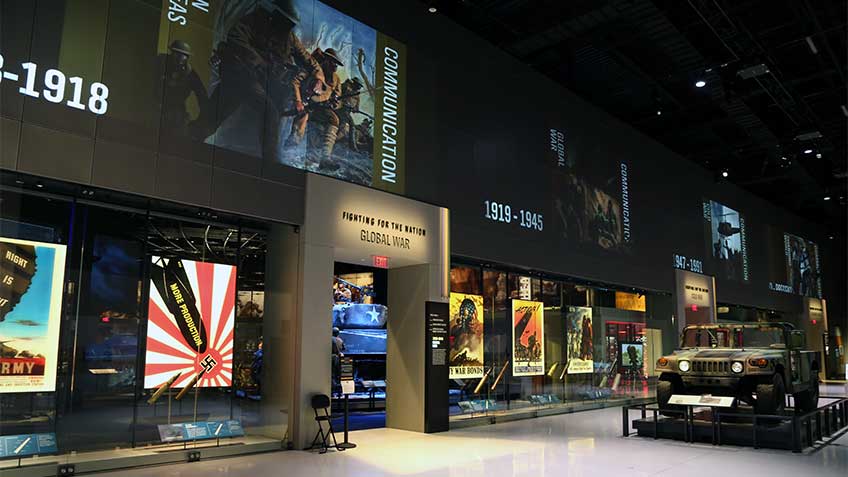
The five-story structure sits on 84 acres of ground and contains nearly 1,400 artifacts spread across 11 galleries that tell the story of the U.S. Army from its founding to its position in the modern world. The heart of the museum and where most artifacts are found lie in seven large galleries that span the history of the Army and highlight key roles it played in the development of the United States.
American Rifleman staff had a chance to view the museum during a media event a week prior to the museum opening its doors. Here are five amazing artifacts you can see when you come down to the National Museum of the United States Army:
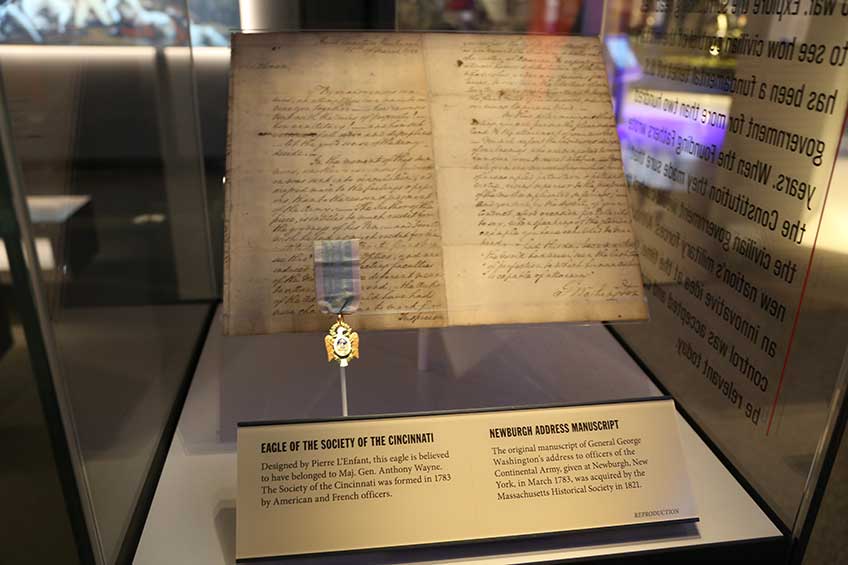
George Washington’s Newburgh Address
In March 1783, the fledgling United States faced a moment of crisis that almost ended the American experiment before it began. While the nation engaged in peace talks with Great Britain, the soldiers and officers of the Continental Army were reaching a breaking point. They hadn’t been paid in more than a year, and the promise of a lifetime pension for the officers still had no source of funding. An anonymous letter circulated the army camp in Newburgh, NY, which stirred talk of rebellion and a possible military coup against the Continental Congress.
When George Washington heard these rumblings, he knew immediate action was required. What followed on March 15 was one of Washington’s finest hours and a defining moment in the early history of the nation. Washington told his men to be patient, saying that doing so would prove their “unexampled patriotism…rising superior to the pressure of the most complicated sufferings.” After the address, Washington stirred the emotions of his men as he struggled to read a letter from Congress. After faltering, he paused and said, “Gentlemen, you will permit me to put on my spectacles, for I have not only grown gray but almost blind in the service of my country.”
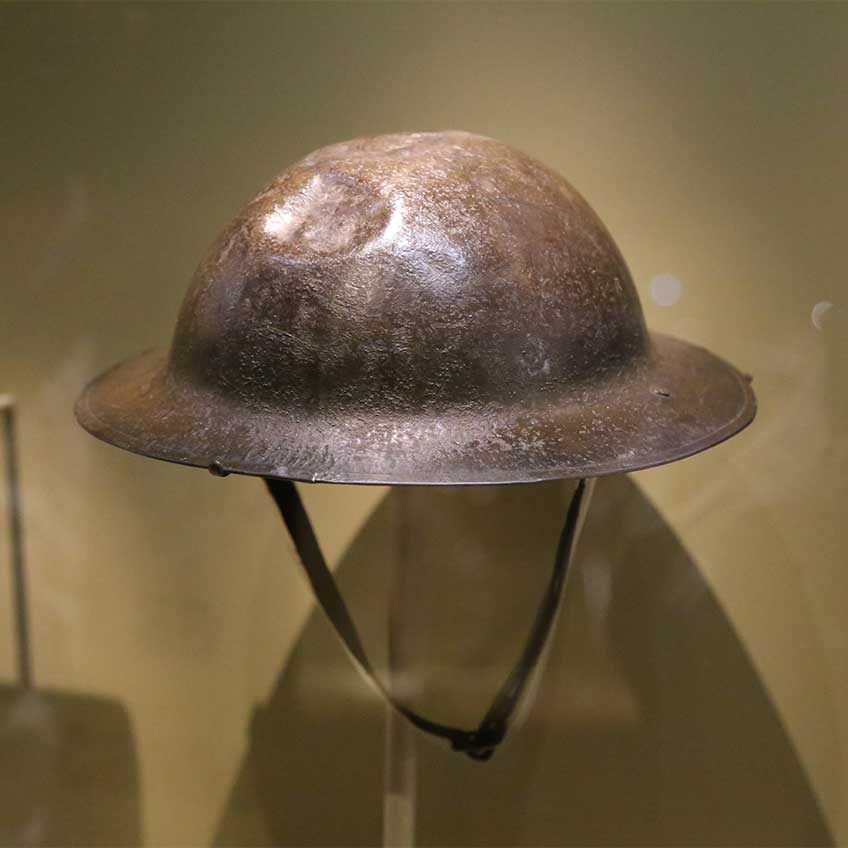
Sgt. Alvin York’s Helmet
In October 1918, then-Corporal Alvin York of the 82nd Division of the U.S. Army joined a group of American soldiers with a mission to take out a machine-gun position in the German lines during the Meuse-Argonne Offensive. While wearing the helmet pictured above, York and his men suddenly came under fire from a German machine gun while dealing with a group of captured German soldiers. To deal with this threat, York embarked on a series of incredible actions that would see him awarded the Medal of Honor.
Likely armed with an M1903 Springfield rifle, York lowered himself and began “touching off” the German machine gunners as quickly as he could. Then, six German soldiers with bayonets fixed charged York, who had expended all the rounds in his rifle. York then drew his M1911 pistol and shot each German soldier, from back to front. Ultimately, through his individual actions, York silenced all the machine-gun positions in the area and captured 132 German soldiers. French Marshal Ferdinand Foch remarked that it “was the greatest thing accomplished by any soldier in all the armies of Europe.”
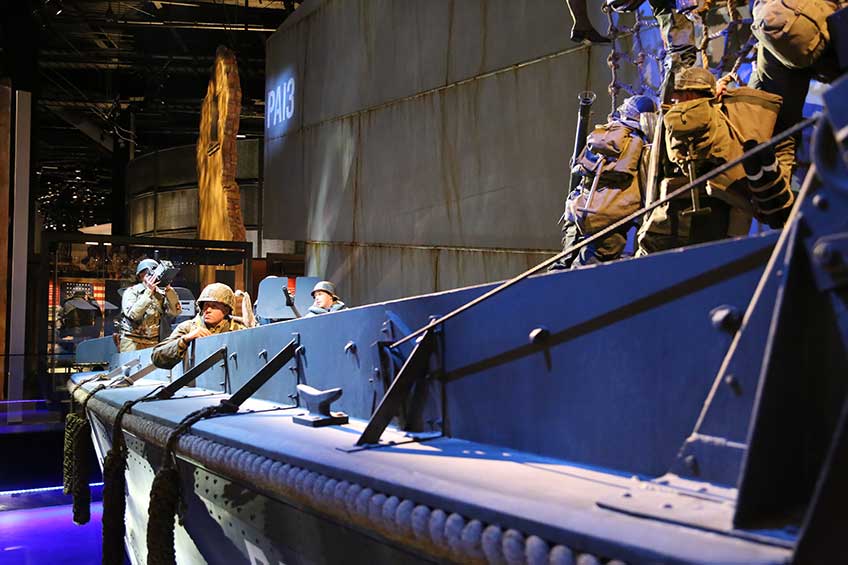
D-Day LCVP
As part of Operation Overlord, the beach landings in Normandy on June 6, 1944, represented one of the largest seaborne invasions in human history. More than 150,000 soldiers supported by nearly 200,000 naval personnel aligned themselves off the northern Channel coast with the aim of cracking Hitler’s Atlantic Wall and establishing a beachhead. The Allied invasion assembled the largest fleet of ships ever gathered.
Nearly 7,000 vessels from eight different navies made up the fleet, and 4,126 landing craft were the largest part of the assemblage, all designed to ferry fighting men from the ships to the five invasion beaches. Of these landing craft, one of the most famous is the “Landing Craft, Vehicle, Personnel” (LCVP), more popularly known as the “Higgins boat” after its designer, Andrew Higgins. More than 23,000 Higgins boats were produced during the war for use in the Atlantic and Pacific theaters. Few survive today, and even fewer are known to have been used in the Normandy landings. The Higgins boat at the National Museum of the U.S. Army is one of six known survivors from D-Day.
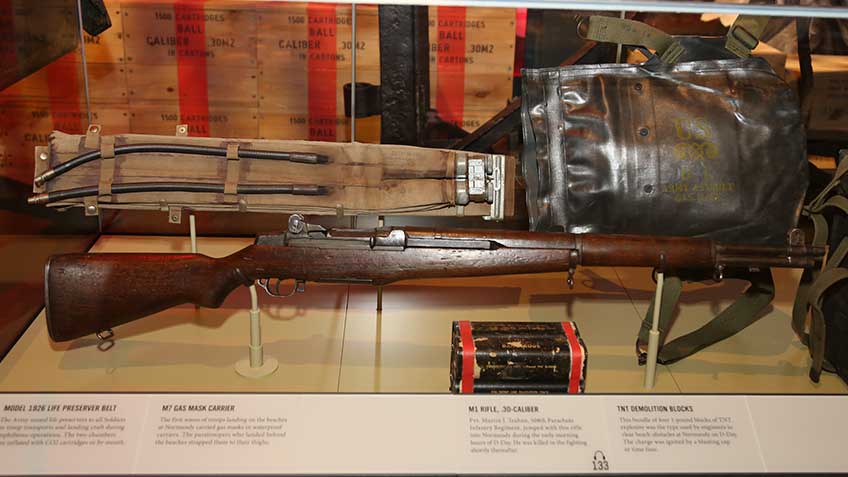
Pvt. Martin J. Teahan’s M1 Garand
At 2:15 a.m. on June 6, 1944, the 508th Parachute Infantry Regiment (PIR) of the 82nd Airborne took part in the opening phase of Operation Overlord, jumping behind German lines. The 508th PIR’s objectives were to capture the French town of Sainte-Mère-Église, secure Merderet River crossings and establish defensive positions in preparation for the Normandy landings. Among those who jumped from the skies that morning was 21-year-old Pvt. Martin J. Teahan.
He joined his comrades in the heavy fighting on D-Day, and while scouting near Picauville, France, Pvt. Teahan was shot in the leg, captured and later killed by a German soldier. Several days after the landing, a French farmer found an M1 Garand engraved with the name “M. Teahan” and held onto it for 72 years until its discovery in 2016. Pvt. Teahan is one of 9,388 American soldiers who lie in the Normandy American cemetery near Colleville-sur-Mer, France, but the rifle he fought with has an honored place in the U.S. Army’s National Museum.
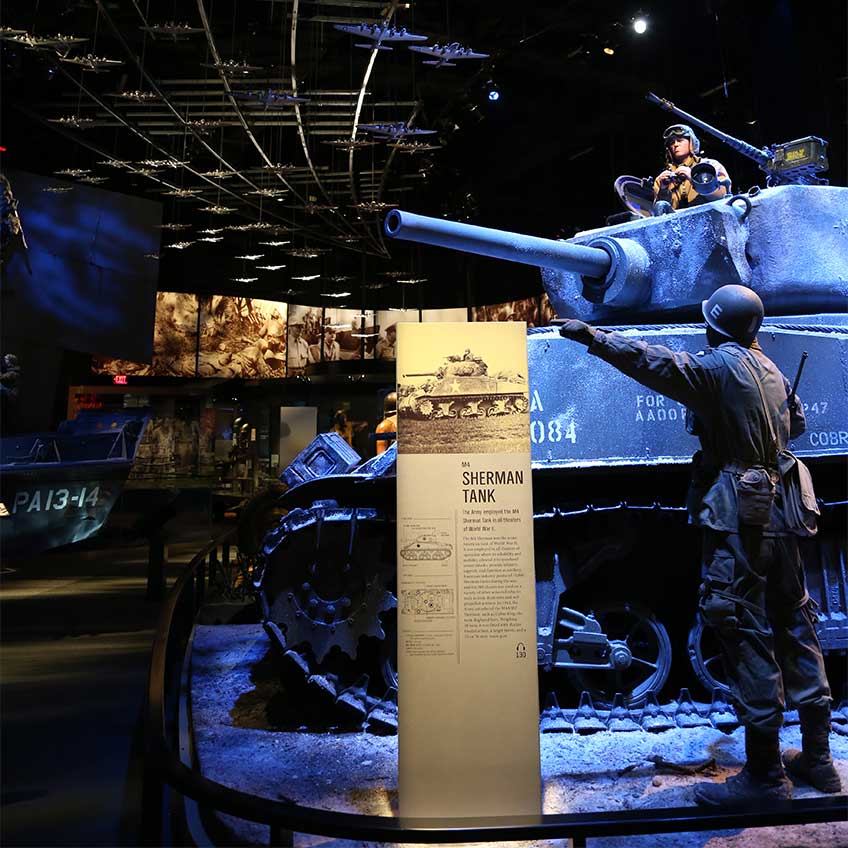
M4A3E2 Sherman “Cobra King”
During the winter of 1944, Allied armies were making significant progress against the Nazi war machine. The combined forces of the British and Americans on the Western Front of World War II had brought them nearly to the border of Germany itself. Hitler and his command staff had only enough men and materiel to mount one last offensive. Known today as the “Battle of the Bulge,” the German blow pushed through the Ardennes Forest with the aim of splitting the Allied lines. The Germans hoped this would destroy the Allied armies in northwestern France and prevent the use of the Antwerp port, forcing them into a surrender settlement.
While the German advance accomplished none of its aims, the assaulting force managed to surround the 101st Airborne in the Belgian town of Bastogne. With heavy cloud cover preventing any reliable means of air support or resupply, the men of the 101st Airborne held out against the odds during five days of heavy fighting. On Dec. 26, 1944, lead elements of the 37th Tank Battalion of the 4th Armored Division broke through German lines, effectively ending the siege of Bastogne. At the head of the column was “Cobra King,” an M4A3E2 Sherman tank that held the honor of being the first unit through the lines.
These are just five of the nearly 1,400 artifacts visitors can see in the National Museum of the U.S. Army, and there are many more priceless artifacts that tell the story of the nation through the eyes of its soldiers. From the rifles of the American Revolution to an engine recovered from one of the helicopters immortalized in “Blackhawk Down,” there’s something for everyone to see.
Museum entry is free, but timed-entry tickets are required and can be reserved on the museum’s website. The museum is open from 9 a.m. to 5 p.m. and is closed Christmas Day. Parking is free, and the museum is located 25 minutes from Ronald Reagan Washington National Airport. For more information, visit thenmusa.org.
.jpg)

LOCALS in Louisiana were left stunned to find one of Putin’s prized T-90 tanks that was seized by Ukranian forces parked at a truck stop.
The monstrous military vehicle was dumped in a parking lot off the Interstate 10 highway after being shipped over to the United States.
Employees at Peto’s Travel Center and Casino in Roanoke were stunned when they saw the terrifying tank plonked outside.
A shipping label on the side of the barrel of the main gun suggests it may have been shipped over from Gdynia, Poland.
Open source intelligence trackers claim the T-90A tank was captured by Ukrainian forces last September amid Russia’s disastrous invasion.
The formidable Russian motor was left unattended at the truck stop for several days, leaving passing drivers baffled.
The state-of-the-art tank was being hauled across the state of Louisiana when the transmission on the truck suddenly went out.
The driver had to go to Houston to replace his mode of transport and asked staff at Peto’s if he could leave the tank there until he returned, according to The Drive.
Assistant manager Valerie Mott said: “I’ve been here seven years. I’ve never seen [a tank] here before.”
She said the truck stop was under the watchful eye of security guards 24 hours a day in case any military fanatics got too giddy.
The tank seems to have sustained some damage to its front and rear fenders, as well as lacking some Western fire control components that they are usually equipped with.
A shipping label suggests it may have been transported from Poland by an organization known as the “multinational assessment field team.”
It is thought the armored vehicle may be headed to the US Army Aberdeen Test Center (ATC) in Maryland for weapons testing or training exercises.
The tank, believed to have been constructed in 2004, is thought to have been captured in Kharviv last September from Putin‘s soldiers by Ukraine’s 92nd Separate Mechanized Brigade.
The Russian troops who ditched their motor were with the 27th Separate Guards Motorized Rifle Brigade, 1st Guards Tank Army.
The tank is expected to be examined by the US military to gain insight into the equipment Russia relies on in battle.
Experts can assess its capabilities and vulnerabilities through reverse engineering.
It is believed that Ukrainian forces may have already stripped some key components after seizing the T-90.
Its sheer presence sparked a panic in Louisiana, as people feared it may have been tampered with while sitting idly for several days.
The trucking company transporting the tank nor military officials have yet to publicly address the incident.
The bizarre guest in the Peto’s parking lot has left many Americans with more questions than answers.
Images of the tank were shared on Reddit by a motorist who lives nearby after he spotted it while driving past.
The post read: “I’m some guy in the south who happens to like tanks from playing War Thunder and stumbled upon this beauty.”
His computer game dreams seemed to have come to life after he extraordinarily found the tank as it made its baffling journey.
Ukraine previously claimed that a T-90 tank they had captured was stuffed with technology made by French firm Thales.
There has been an arms embargo for European firms supplying Russia with equipment since the annexation of Crimea in 2014.
But reports say €346 million worth of military gear was sold to Russia by continental manufacturers after that.
